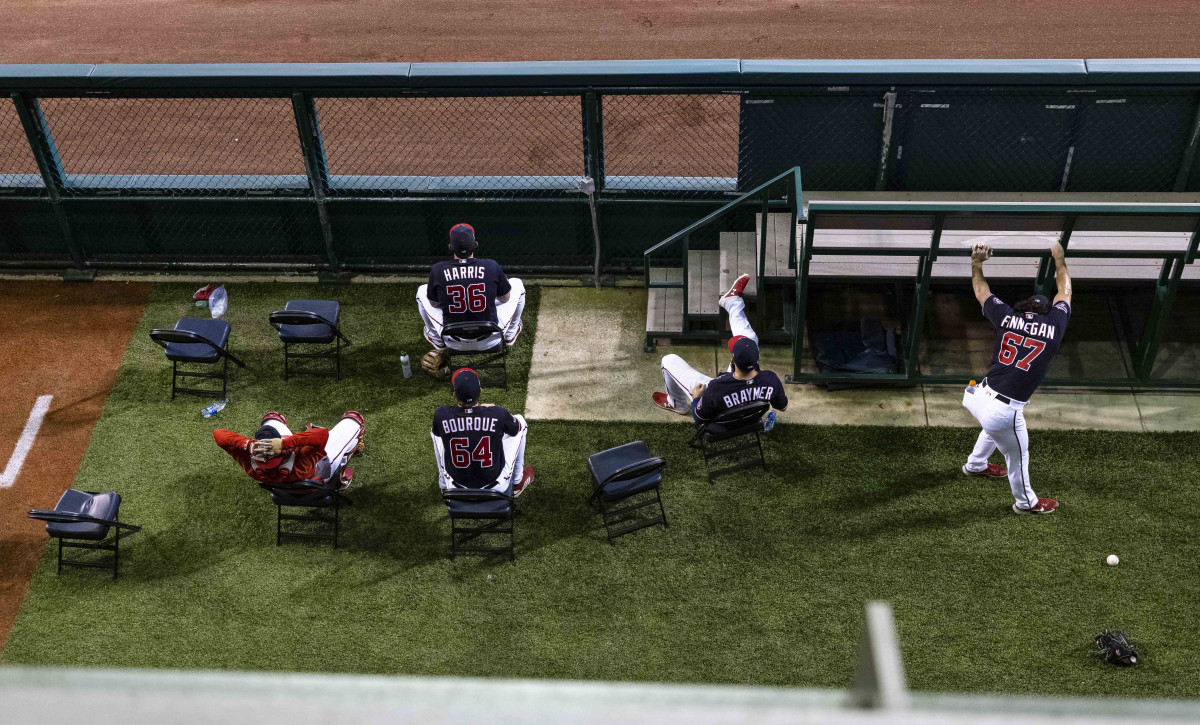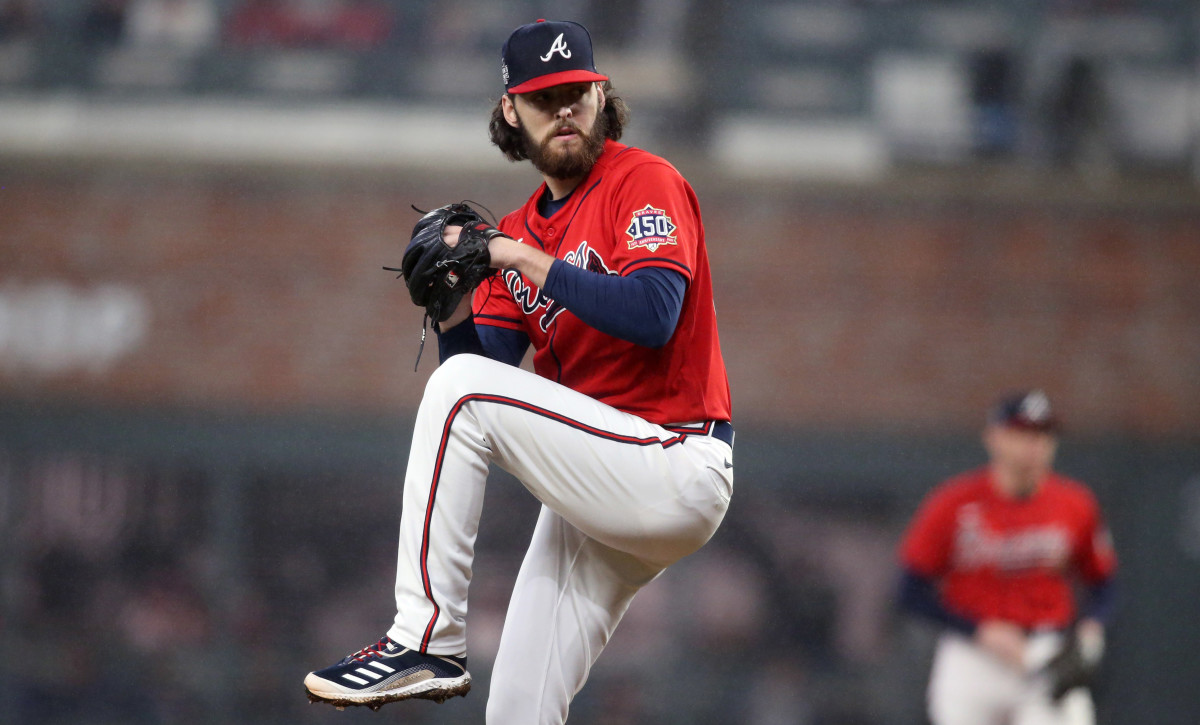Baseball's Starting Pitching Problem Is on Full Display During This Postseason

ATLANTA — Watching a blockbuster action movie on your phone. Driving a tightly tuned sports car with a donut spare tire. Listening to the Vienna Philharmonic on cheap headphones. Watching what has become of baseball and its starting pitching.
The thrill is gone.
We are kings of convenience. The Braves beat the Astros in World Series Game 3 Friday night, 2–0, in what might have been an all-time classic, what with a no-hitter in place through seven innings on a dank, Dickensian kind of evening. Instead, two runs scored. Eleven pitchers were used. No history was written. Unless you are into infamy.
This was the 47th regulation World Series game in which only one or two runs scored. It took the longest time (3:24) among all those without a bottom of the ninth.
There have been 681 World Series games played. This was the first one with so many pitchers and so few runs.
Braves manager Brian Snitker pulled his starting pitcher, Ian Anderson, after only five innings and 76 pitches with a World Series no-hitter in place. Anderson is not some back-of-the-rotation starter or opener. He is a gifted, ace-level pitcher who owns a postseason ERA of 1.26 in eight starts. In another time he would be Eddie Plank (1.32) or Madison Bumgarner (2.11), an October legend.
Baseball no longer allows such legends. Even a baseball lifer like Snitker, who is 66 years old and spent 28 years paying dues in the minors, knows how the game is played today. Snitker was not wrong to remove Anderson and hand the ball to A.J. Minter, and then to Luke Jackson and then to Tyler Matzek and then to Will Smith.
It’s just that the right way to play today is wrong for baseball’s tomorrow. Soon the players and owners will renew their usual squabble over economic issues as they attempt to reach a new collective bargaining agreement. Meanwhile, the true threat to baseball is the aesthetics of the game—pace of play, including the enormous influence of pitching changes on declining offense and length of games. It is the climate change issue of baseball.

Once upon a time, starting pitchers were stars who drove interest and attendance. Shea Stadium attendance jumped when the morning newspaper said Dwight Gooden was pitching that night. But you don’t need to tell stories that go all the way back to Old Hoss Radbourn or Bob Gibson, Sandy Koufax and Jack Morris when you lament the loss of baseball’s leading men.
You need only go back to Stephen Strasburg in 2019. Exactly two years ago from Friday night, Strasburg took the ball into the ninth inning of World Series Game 6 for the Nationals. None of the last 20 World Series starters since then have thrown even seven innings.
It has happened that fast. The bull-penning of baseball jumped the shark last year when Tampa Bay manager Kevin Cash removed an effective Blake Snell just because the lineup turned over a third time. The Rays lost. Snitker removed Anderson at the same point—after two turns through the lineup. This time it worked, or else Snitker would have been Cashed.
“He still had it,” catcher Travis d’Arnaud says of Anderson. “He only went through the order two times and I don’t think [leadoff batter Jose] Altuve had a comfortable at-bat, neither did [Michael] Brantley, neither did [Alex] Bregman, neither did [Yordan] Alvarez … I don’t know what his pitch count was.”
Seventy-six.
“Either way,” d’Arnaud says. “I trust our bullpen, so either way is good.”
If this is not the postseason that killed starting pitching it is the one that made it less interesting. The NFL thrives because of quarterbacks. The league constantly changes its rules to cater to their health and the completion rate of passes, which facilitates comebacks—the true appeal of sports—and turns the quarterbacks into stars.
Baseball has taken the stars that starting pitchers used to be and turned them into game managers. Their task: just don’t lose the game. Here are the lagging vital signs from this postseason:
• Starters are 13—20 in 34 games while averaging 3.97 innings per start.
• Starters have thrown 100 pitches only three times out of 68 starts.
• Relief pitchers account for 62% of the wins and 55% of the innings.
• The pitching duel is dead. Not once in 34 games has each starter pitched seven innings.
Let’s be clear again: Snitker managed correctly in Game 3. It’s not his job to worry about aesthetics. It is his job to win. The problem is not the managers. It is the relief pitchers. There are too many who are too good. Pitching labs have figured out that spin and velocity can be taught and crafted.
Take Phil Maton, for instance. He went undrafted out of high school and undrafted after three years at Louisiana Tech. The Padres finally drafted him in the 20th round in 2015 as a college senior. Maton had always been taught to keep his fastball down. Upon being drafted, the Padres sent him to their short season team, the Tri-City Dust Devils in Pasco, Wash. That’s where he heard about spin rate for the first time. The Dust Devils measured his fastball with TrackMan technology. They found this 20th round pick who was told to keep his fastball down had major league spin rate.
“Throw your fastball high in the zone,” said the pitching coach there, Nelson Cruz.
Maton promptly rocketed up the system, reaching the big leagues two years after getting drafted in the 20th round. The Padres traded him to Cleveland, which traded him to the Astros this year. His fastball generates the third-highest whiff rate in baseball, even at 91.5 mph.
These Maton stories are happening with every team on every level every year. The inventory is what has changed baseball. Managers were once reluctant to go to more than two or three arms deep in their bullpen with a lead. Now they happily go five or six deep.
Bullpens kill starting pitching legends, and they kill comebacks. The team that scores first is 3–0 in this World Series and 27–7 in the postseason. Score first and you win almost 80% of the time in this new postseason world. Where is the drama in that?
Offense disappears when the best arms form their late-inning relay race. Batters in this World Series are hitting .182 after the sixth inning.
Two years ago, Anderson stays in the game, and phones everywhere buzz with news that he has a chance to join Don Larsen as the only pitchers to throw a World Series no-hitter. TV sets that had been off are turned on. This time Snitker would have none of it.
The Astros had looked bewildered by Anderson’s changeup. In the fourth, Anderson tripled up on his changeup to Brantley. Even though Brantley saw three in a row in nearly the same location, he swung and missed on the third for a strikeout. Anderson obtained nine of his 15 outs on the changeup.
In his career, which began last year (he is technically still a rookie), Anderson has allowed a .157 batting average on his changeup. If you take all the pitchers and all the pitches they have thrown over the past two years (minimum 1,000 pitches, postseason included), Anderson’s changeup is the fourth-toughest pitch to hit in MLB, behind only the curves of Framber Valdez (.128) and Charlie Morton (.148) and the splitter of Kevin Gausman (.130).

Most impressively, would-be October legend Anderson has held hitters on his changeup in his postseason career to an .074 batting average.
“Yeah, I knew I had good stuff,” Anderson says. “[Martín] Maldonado hit that ball up the middle [for a groundout], but other than that there wasn’t much hard contact.”
I ask Anderson, “You had a no-hitter in the World Series—with 76 pitches. Honestly, how did you feel to be taken out?”
“I did fight it,” he says.
To what level did you fight it?
“I was just holding on to his hand pretty tight in that handshake,” Anderson says, “You have to trust those [bullpen] guys. Those guys are so good.”
Specialization is the name of the game. Minter this postseason has allowed a .100 batting average on his cutter (0-for-3 in Game 3). Jackson has the most movement on any slider in the game (0-for-3 in Game 3). Matzek has allowed one hit on his slider since June 24 (0-for-1 in Game 3). Smith has allowed a .188 batting average on his two breaking pitches (0-for-2 in Game 3).
Sorry, once Anderson was lifted, the idea of a no-hitter lost its appeal. A combined no-hitter is to baseball fame what “Four Dogs Playing Poker” is to the art world: quirky, but there’s no prestige in ownership.
On Thursday, the animal rights group PETA released a statement, on behalf of the cow kingdom, advocating the banishment of the term “bullpen.” PETA, in apparent all seriousness, suggested “arm barn” as a replacement. We could go to “Kings of Convenience” to refer to relievers if it wasn’t already the property of a Norwegian indie folk-pop duo. Kings of Convenience released an album in 2009 called “Declaration of Dependence.” When it comes to how managers treat relief pitching, that can also stand as the title of this postseason
More MLB Coverage:
• The Braves Shut Down Baseball's Best Offense to Earn World Series Edge
• Why Does MLB Still Allow Synchronized, Team-Sanctioned Racism in Atlanta?
• How Does Atlanta Handle Its Pitching Going Forward?
• Jose Altuve Snaps His Slump With the Help of a Playoff Legend
